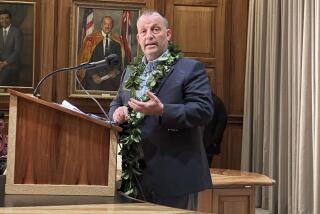A Language Once Thought Dying Is Having a Rebirth : Outlook brightens as an immersion program to revive Hawaiian takes root. But some fear separatism.
HONOLULU — Several years ago, the Hawaiian language seemed headed for oblivion. Native speakers were dying of old age, and few children grew up speaking the sonorous ancient language.
“It was desperate and fading away fast,” Hawaiian specialist Kauanoe Kamana said. “It was just on the edge of existence as a viable language.”
Hawaiian was officially suppressed when the United States annexed the islands in 1898 and fell out of use as Hawaii became Americanized. Except for a handful of popular words and the lilting lyrics of Hawaiian music, the language is seldom heard in the 50th state.
But, today, the outlook for Hawaiian has brightened. At the heart of the reversal is a Hawaiian immersion program begun in a private preschool in 1984 that has spread--not without controversy--to public schools. This fall, nearly 500 children, ages 2 to 11, will be taught entirely in Hawaiian.
For those students and their parents, the voluntary immersion programs represent a chance to save their ancestral language and recapture a lost identity and pride.
“The essence of the culture is our language,” said Wehi Naauao, whose children, ages 5, 6 and 9, study only in Hawaiian. “Without the language, we’re no different from anyone else.”
But critics fear that pulling children out of English-language school will handicap them and could eventually sow the seeds of conflict.
“This exclusive Hawaiian program usurps the influential formative learning years, the worst time in a child’s life to retreat to the past,” warned Billie Beamer, a part-Hawaiian and last year’s Republican candidate for lieutenant governor. “When a child is schooled in a language that has only 25,000 words, that in itself is stultifying.”
A. A. (Bud) Smyser, a columnist for the Honolulu Star-Bulletin, worries about the long-term effects. “Where does this road lead us?” he asked. “Is this a first step toward a separated society like that of the French in Canada, the Catholics in Northern Ireland or the Indians in Fiji . . . ?”
Proponents of immersion dismiss such rumblings, saying they raise unnecessary fears and doom the language to extinction. Only if children grow up speaking Hawaiian can the language live and adapt to the modern world, they contend, pointing to successful efforts to revive the Maori language in New Zealand and Welsh in the United Kingdom.
“The whole reason there are shortcomings is because people abandoned the language for many, many years,” said Kamana, president of Aha Punana Leo, which created the first Hawaiian preschool and now runs five of them. “If you don’t have enough words, then you must create words. That’s what English does . . . .”
Given the “overpowering” role of English in Hawaii, she sees little reason to fear that it will get short shrift. “It’s impossible,” she said, “for a baby to be born here and not learn English.”
But some question that. Considering the popularity of pidgin and Hawaii’s large immigrant population, they say, schools need to focus on English.
Under the current program, English is introduced as a “foreign” language in fifth grade. By the end of the sixth grade, students are supposed to be bilingual. Studies show that immersion students easily transfer their skills to a second language.
The new emphasis on Hawaiian grows in part out of a renaissance in the native culture that began in the 1970s, when local music flourished and students began flocking to hula schools. At the 1978 constitutional convention, Hawaiian was made an official language of the state, along with English. In 1986, the Legislature lifted the nearly century-old ban on schools teaching only in Hawaiian.
Five public elementary schools now offer Hawaiian immersion. Students greet each other with “Aloha kakahiaka, “ instead of “Good morning,” and start their day by reciting a short speech that reflects traditional Hawaiian values, including hospitality to visitors.
Administrators say the immersion students are thriving.
“This program shows great potential for overcoming some of the problems that Hawaiian youngsters have had in the school system,” said Richard Port, educational specialist for the state. “They have a strong sense of accomplishment and achievement, and it puts them also in tune with their own culture.”
When the state education budget had to be pared recently, the Board of Education gave Hawaiian immersion a top priority for full funding.
“If Hawaiian is no longer spoken in Hawaii, there will be nowhere else to go to speak or learn Hawaiian,” Port said. “It’s here or nowhere.”
More to Read
Sign up for Essential California
The most important California stories and recommendations in your inbox every morning.
You may occasionally receive promotional content from the Los Angeles Times.










